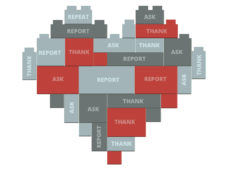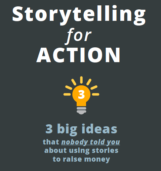Fundraising events are one of the hardest things to do well in fundraising. They are hard to plan, there are a TON of variables, they require a lot of people, and often take a real toll on nonprofit staffs. My hat is off to anyone to plans and puts on an event.
We’re nearing ‘fall event season’ and the other day a client asked what our top three tips for a successful event are. So here they are, and I should also be clear that these tips are for organizations raising between $0 and about $5,000,000. (Organizations larger than $5m tend to have a different set of issues.)
Without further ado, here’s how we think about it . . .
1. Have a clear offer and price point:
Be clear and specific about what the donor’s gift will accomplish. In other words, be able to describe exactly what the donors’ gift will do. We’ve had incredible success helping organizations transition from asking donors to “please donate to help us help more people” or “donate to the annual fund” to things like “Provide one night of safety for a mom for $53.”
Please note: you can do this and still raise undesignated funds. What you want to do is to focus on one specific outcome that donors gifts create, but also be clear that their gifts will be used to help do all the things your ministry does.
2. The whole event should be designed to present the Ask:
You want to plan your event so that everything in it — from the program to who speaks to the main speaker — shows the need for your offer (and how powerful it is). For instance, say your offer for the night is “$53 provides one night of safety.” You might name your event “One Night Of Safety.” When your Executive Director speaks, she should talk about how powerful one night of safety is. If you have a beneficiary speak, have her talk about how incredible her first night of safety was.
This may sound repetitive, but it works like crazy. The key here is that if you highlight one powerful part of your organization to focus on you’ll do far better than if you ask donors to buy into the whole organization.
Doing this also helps you avoid the dreaded “OMG another speaker?!?” that happens when organizations have too many speakers. If you focus the entire event on delivering the offer and presenting the ask, you don’t have time for all those speakers!
3. Don’t share too much good news until after the Ask:
A lot of nonprofits shoot themselves in the foot on this one. They share success story after success story. This makes it seem like everything is going great and no one needs help. THEN they ask for a gift. That’s a surefire way to reduce donations.
What has increased event revenue for our clients every single time has been to tell a Story Of Need. This means talking about a person who needs help today. Or if it’s a beneficiary speaking, have them spend 80% of their time on what it was like to need help. What we’re trying to do is to make the people in the room emotionally feel the problem so that they are more likely to help.
This is counterintuitive for most organizations. At some level they believe that, “If we show a couple of success stories people will know we’re good at what we do, then they will be more likely to donate.”
But what we’ve proven true is that it’s more helpful to think, “If we show the people that someone really needs help today, and that we have a plan to help them, more people will donate.”
Then, after the Ask, celebrate wildly. Let people know the amazing thing their gifts are going to do.
Bonus Tip: Now you’re able to Report with power.
Because you asked people to help with a specific thing, you can now Report to those donors with a specific story about the specific thing they did. Other events aren’t able to tell donors what their donation accomplished. But if you follow this recipe for success your donors will LOVE hearing what their gift did. And they’ll be far more likely to become recurring donors to your organization!
I hope this list has been helpful. As you enter event season, good luck!
Steven Screen is Co-Founder of The Better Fundraising Company and lead author of its blog. With over 30 years' fundraising experience, he gets energized by helping organizations understand how they can raise more money. He’s a second-generation fundraiser, a past winner of the Direct Mail Package of the Year, and data-driven.









Thank you for the information and tips for event success. I definitely like the idea to accurately tell the guests what their money is going towards and what it will accomplish. Everyone is more likely to donate if they know exactly how their money is going to help. Thank you for the tips, I’ll be sure to pass them on.
Jaque – That’s a piece of fundraising knowledge that can be applied across all of your fundraising – direct mail, events, major donor work, etc.!